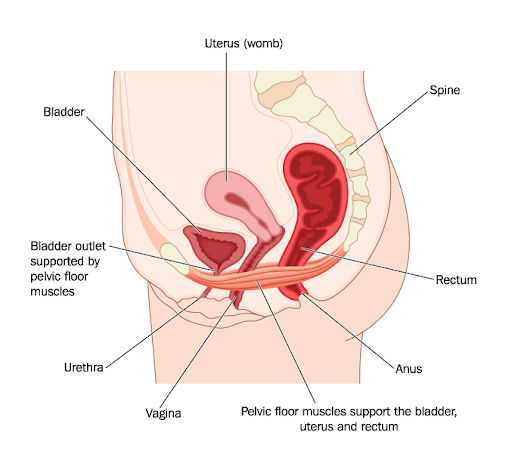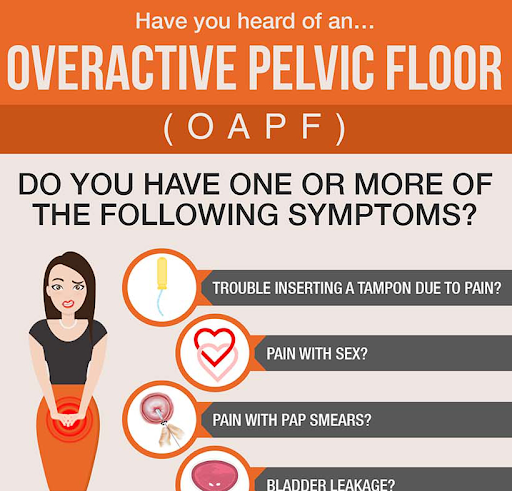
Overactive pelvic floor muscles, also referred to as hypertonic pelvic floor muscles, happen when the pelvic floor muscles are unable to relax. With the muscles constantly working, this leads to chronically tight pelvic floor muscles, which can lead to muscle spasm, muscle tension, and pelvic muscle pain. Like other muscles in the body, they can be in spasm or very tight, in a constant state of contraction. When they are working this way, they can’t relax.

What causes overactive pelvic floor muscles?
Because the muscles affected by this condition are internal, it’s likely they’ve never received much conscious thought, particularly in one’s youth. Until issues arise that impact daily life, we tend to take for granted that this area of the body will simply continue to function healthily, with the muscles providing uninterrupted support to the organs.
So, what causes a hypertonic pelvic floor?
One might believe they’re following all the best practices, such as performing pelvic floor exercises regularly. However, it’s important to remember that while pelvic floor squeezes are great, they may not prevent the development of excessive tightness in this area. Furthermore, they are certainly not a cure for hypertonicity.
-
Excessive Pelvic Floor Exercise: If you over-extend the pelvic muscles through too much exercise, they can become over-strengthened and tight.
-
Incorrect Pelvic Floor Exercise Technique: Performing pelvic floor exercises incorrectly can lead to localised areas of muscle tension and weakness
-
Pelvic Infection: Pelvic infections can cause inflammation of the tissues, leading to tightening and swelling.
-
Emotional or Mental Health Factors: The pelvic floor muscles can tense in response to past traumas or emotional stressors. Additionally, everyday stress can contribute to unconscious muscle tension. Techniques like mindfulness and stress management can be helpful in addressing these factors.
-
Poor Posture: Poor posture can lead to certain parts of the body overworking to compensate for others. Maintaining good posture can help to prevent pelvic floor dysfunction.
-
Habitual Incomplete Emptying: Improper bladder and bowel emptying habits formed in earlier years can contribute to a tight pelvic floor. This can be due to difficulty fully relaxing those muscles.
-
Urinary Frequency Suppression: Lifestyle factors or occupations that limit access to toilets can lead to frequent suppression of the urge to urinate. This can cause pelvic floor dyssynergia, where the muscles don’t coordinate effectively.
-
Painful Sex (Dyspareunia): While dyspareunia can be a symptom of a tight pelvic floor, continuing to have painful sex can inadvertently exacerbate the condition as the muscles tense further in an attempt to prevent discomfort.
What are the symptoms of overactive floor muscles?
Bladder changes:
- Slow flow
- Difficulty initiating the flow
- Incomplete bladder emptying
- Recurrent Urinary Tract Infections
- Urinary incontinence
- Urgency
Bowel changes:
- Constipation
- Difficulty evacuating the bowels
- Difficulty initiating bowel movement
- Straining to empty bowels. This can cause pain and can result in spasms of the pelvic floor muscles and increased tension.
Sexual changes:
- Pain on deep penetration
- Pain at the vaginal entrance
- Inability to achieve penetration
- Inability to have an orgasm
- Abdominal and pelvic pain
- Vaginal aching

How is it treated?
While a super-toned pelvic floor might sound impressive, imagine holding a plank for dear life all day long – that’s what an overactive pelvic floor is like! The muscles are constantly clenched, which ironically makes them weak and fatigued.
To tackle this situation, we need to identify the culprit behind the overactivity. It could be a combination of things, like the muscles themselves being a bit too tense on standby, occasional muscle spasms, or even poor communication between the muscles and the brain. Stress and past experiences can also play a part.
The key lies in teaching your body to let go of that unwanted tension. Often, incorporating some breathwork exercises can be a breath of fresh air (pun intended!), helping the muscles relax and return to a happier state.
-
Knowledge is Power: Understanding what’s going on down there (so to speak) is crucial. I’ll explain how an overactive pelvic floor is contributing to your symptoms, and trust me, clear information makes a world of difference in regaining control.
-
Downtraining Your Downstairs: Imagine weight training in reverse! We’ll teach you how to consciously contract and then completely relax your pelvic floor muscles. Think of it like mindfulness for your muscles, and I might even use biofeedback tools like a trusty mirror or a gentle internal exam (don’t worry, it’s nothing too scary!) to help you visualise and feel what’s happening.
-
Release the Tension: If there are muscle spasms involved, we might use gentle stretches and internal releases to help your pelvic floor muscles loosen up and move more freely.
-
Stretching it Out: Just like any other muscle, stretching can be beneficial for the pelvic floor too. We’ll show you some targeted stretches to improve flexibility and overall comfort.
-
Taming the Mind-Body Connection: Sometimes, stress and anxiety can fuel pelvic floor problems. If this sounds familiar, we might recommend talking to a psychologist or sexual health counsellor to help address those deeper concerns.
-
Building a Strong Foundation: Don’t forget your hips! Strengthening the muscles around your hips can take some of the pressure off your pelvic floor, creating a more balanced and supportive system.

I hope this is helpful and explains the natural process we all go through to allow our babies to grow. As physios, we need to ensure we are spreading the right message.
Don’t hesitate to reach out if you have any questions or need guidance on safe and effective treatment.







